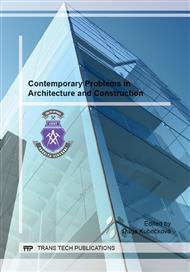[1]
Glued Laminated Timber Association, Technical Data Sheet No. 1 Glulam In Sports Hall, Guide To Fire Requirements.
Google Scholar
[2]
M. Rajczyk, D. Jończyk, Modeling of Fire-Resistant Timber Structures Using the Finite Element Method, Vestink grazdanskih inzenerov 4 (2013) 104-109.
Google Scholar
[3]
M. Audebert, D. Dhima, M. Taazount, A. Bouchaïr, Numerical investigations on the thermo-mechanical behavior of steel-to-timber joints exposed to fire, Engineering Structures 33 (2011) 3257-3268.
DOI: 10.1016/j.engstruct.2011.08.021
Google Scholar
[4]
M. Audebert, D. Dhima, M. Taazount, A. Bouchaïr, Behavior of dowelled and bolted steel-to-timber connections exposed to fire, Engineering Structures 39 (2012) 116-125.
DOI: 10.1016/j.engstruct.2012.02.010
Google Scholar
[5]
M. Audebert, D. Dhima, M. Taazount, A. Bouchaïr, Thermo-mechanical behavior of timber-to-timber connections exposed to fire, Fire Safety Journal 56 (2013) 52-64.
DOI: 10.1016/j.firesaf.2013.01.007
Google Scholar
[6]
M. Audebert, D. Dhima, M. Taazount, A. Bouchaïr, Experimental and numerical analysis of timber connections in tension perpendicular to grain in fire, Fire Safety Journal, 63 (2014) 125-137.
DOI: 10.1016/j.firesaf.2013.11.011
Google Scholar
[7]
P. Racher, K. Laplanche, D. Dhimab, A. Bouchaïr, Thermo-mechanical analysis of the fire performance of dowelled timber connection, Engineering Structures 32 (2010) 1148-1157.
DOI: 10.1016/j.engstruct.2009.12.041
Google Scholar
[8]
K. Laplanche, D. Dhima, P. Racher, Thermo-mechanical analysis of the timber connection under fire using 3D finite element model, Proceedings of the 9th World Conference on Timber Engineering, Portland, Oregon, USA, August 6-10, (2006).
DOI: 10.1016/j.engstruct.2009.12.041
Google Scholar
[9]
C. Erchinger, A. Frangi, M. Fontana, Fire design of steel-to-timber dowelled connections, Engineering Structures 32 (2010) 580-589.
DOI: 10.1016/j.engstruct.2009.11.004
Google Scholar
[10]
C. Erchinger, A. Frangi, A. Mischler, Thermal investigations on multiple shear steel-to-timber connections, Proceedings of the 9th World Conference on Timber Engineering, Portland, Oregon, USA, August 6-10, (2006).
Google Scholar
[11]
M. Fragiacomo, A. Menis, P. J. Moss, I. Clemente, A. H. Buchanan, Numerical and experimental thermal-structural behaviour of laminated veneer lumber (LVL) exposed to fire, Proceedings of the 10th World Conference on Timber Engineering, Riva del Garda, Trentino, Italy, June 20-24, (2010).
DOI: 10.1260/2040-2317.1.3.145
Google Scholar
[12]
Julio Cesar Molina, Carlito Calil Junior, Numerical analysis of composite structure wood concrete in fire, Proceedings of the 11th World Conference on Timber Engineering, Auckland, USA, July 16-19, (2012).
Google Scholar
[13]
M. Fragiacomo, A. Menis, I. Clemente, G. Bochicchio,B. Tessadri, Experimental and numerical behaviour of crosslaminated timber floors in fire conditions, Proceedings of the 11th World Conference on Timber Engineering, Auckland, USA, July 16-19, (2012).
DOI: 10.1007/s10694-015-0516-8
Google Scholar
[14]
M. Rajczyk, D. Jończyk, Study on Strengthening Glued-Laminated Timber with Aramid Cords and Properties of Composite Materials, Advanced Materials Research 583 (2012) 142-145.
DOI: 10.4028/www.scientific.net/amr.583.142
Google Scholar
[15]
EN 1995-1-2: 2004 Eurocode 5: Design of timber structures - Part 1-2: General - Structural fire design.
Google Scholar
[16]
Kevlar® – Aramid Fiber, Technical Guide.
Google Scholar
[17]
EN 1194: 2000 Timber structures. Glued laminated timber. Strength classes and determination of characteristic values.
DOI: 10.3403/01544431
Google Scholar
[18]
EN 1991-1-2: 2004 Eurocode 1: Actions on structures - Part 1-2: General actions – Actions on structures exposed on fire.
DOI: 10.1002/9783433601570.oth1
Google Scholar


